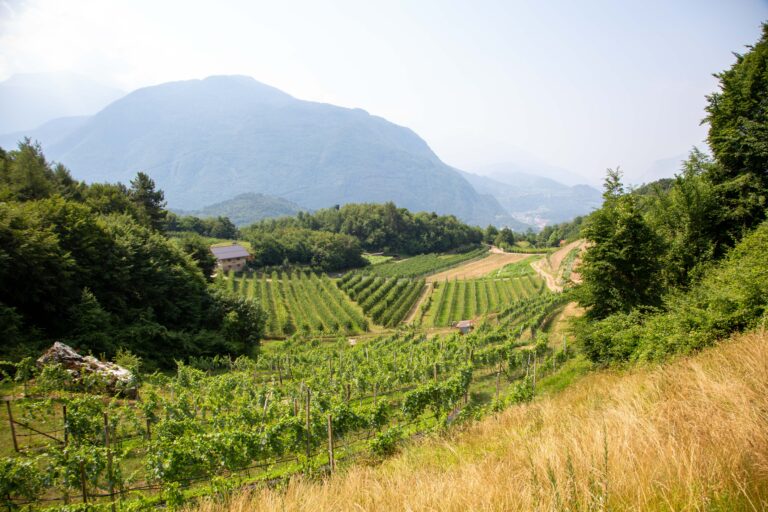
Prognosis
Rapid climate change impacts will lead to increasing conflicts in water and land usage, for this reason IMPETUS is seeking to promote participatory approaches in decision making to ensure rapid transition to sustainable and integrated water management, biodiversity conservation and disaster risk reduction.
Situation
The Valle dei Laghi area is located in the Province of Trento in the Italian Alps. The area has an abundant water supply and a very fragmented population, with small villages and municipalities with less than 5000 inhabitants.
Agriculture and food / wine production, hydropower production, forestry for wood fuel, slow tourism and winter ski tourism are the main economic activities. The Alps, and mountains in general, are recognised hotspots for climate change, with temperatures raising far beyond the average and more frequent extreme weather events.
Climate related issues

Water use
Water scarcity and lack of preventive actions to manage it; water management conflicts.

Land use
Loss of local traditions in agriculture and cultural heritage

Economic impacts
Increased frequency of extreme events and related economic and social damages
Key actions
Thanks to data and knowledge sharing and co-creation with local actors, we are supporting decision-making processes to strengthen the resilience of the territory and the community in the following fields:
- sustainable and integrated management of regional water resource through a Decision Support System;
- analysis of innovative insurance products for agriculture;
- evaluation of the effects of the altitudinal shift of crops on vineyards;
- activating the cultural heritage to enhance climate resilience;
- applying Impact Chains approach to better understand and manage vulnerabilities and risks related to climate change.
Contact us

Valentina D'Alonzo
European Academy of Bolzano
valentina.dalonzo[@]eurac.edu
Events
News
Resources
Relevant sectors:
Municipality
Citizens
Farmers
Energy
Biodiversity
Our ambitions
“Despite the name (Valle dei Laghi means Lakes Valley), in this area rapid climate change impacts are leading to increasing conflicts in water and land usage.
For this reason within the IMPETUS project, we are promoting participatory approaches in the decision making process, involving different local stakeholders, to ensure rapid transition to sustainable and integrated water management, biodiversity conservation and disaster risk reduction.”
Valentina D’Alonzo, European Academy of Bolzano (EURAC)
In the mountain demonstration site, we have set ambitious goals:
- Harmonise and build on existing solutions and initiatives to develop a multi-sectorial / multi-systems innovation package for the region.
- Use operational climate services and products such as satellite data, seasonal forecasts, climate projections to develop co-created medium to long-term plans for water usage and risk management.
- Ensure local community ‘ownership’ of risk management solutions integrating risk analyses and management approaches with participation, communication and co-creation.
- Promote adaptation solutions uptake and transfer to other mountain communities engaging with national and international stakeholders.
- Setting the stage for a network of citizens and stakeholders for their long-term participation in the decision-making process.
- Demonstrate and test the developed solutions for wider uptake at provincial and higher levels as part of a Provincial Strategy for Climate Change Mitigation and Adaptation.





Issues

Water use
- Increasingly conflicting needs for irrigation, drinking water, hydropower exploitation, ecosystems.

Land use
- Conflicts between use for agriculture, flood retention areas, tourism.
- Shifting from woodland to cultivation increases already naturally high risks of hazards associated with mountain landscapes.
Region-specific solutions
Enhanced knowledge and data-driven support for insurances related to the agricultural sector


Our approach:
- Design and test such an insurance system to protect agricultural crops, forest stands and hydropower energy plants against climate-related economic losses;
- Involve stakeholders and experts from agricultural insurance consortia and ethical banking;
- Support the design of insurance and financing models with tailor-made climate risk assessment tools that exploit existing data platforms providing seasonal forecasts and climate projections (e.g., Copernicus, Geo Mountains), enriched by local-scale data, and impact models;
- Allow the economic evaluations to be based on assessment of future return periods for adverse climate events, such as hail, storms, floods, droughts, forest fires, etc.
Activate cultural heritage to enhance climate resilience

Our approach:
- Tap into the regional endogenous knowledge, revealing how culture, values and beliefs influence risk perceptions and enable or impede climate adaptation measures;
- Identify relevant cultural practices in agriculture, water management and buildings regarding their potential for further development, upscaling and transferability, showcasing local best practices in terms of cultural practices to leverage for climate mitigation and adaptation;
- Identify and exploit the interconnected intangible and tangible components of cultural heritage that are an essential part of local identities and shared values;
- Develop tools to foster societal awareness and facilitate win-win solutions for adaptation and implementation of low-carbon measures for historic buildings analysing the existing building stock to investigate its past, present and future performance.
Apply Impact Chains in participatory processes


Our approach:
- Involve local experts in the Mountains demo site in a participatory process;
- Development of Impact Chains for the Valle dei Laghi DS, focusing on the agricultural and built environment sectors;
- Analyse risk management practices in order to identify gaps, points for improvement as well as best practices;
- Pinpoint in which field adaptation measures need to be taken;
- Use the results to foster behavioural change and increase communities’ awareness and adaptive capacity;
- Replicate this activity in other mountainous areas to foster mutual learning and exchange of best practices;
- Exploitation of the Impetus IC application to develop practical guidelines for practitioners and researcher to apply the IC approach.
Decision Support System integrating multiple information layers for the sustainable and integrated management of regional water resource



Our approach:
- Use seasonal hydrological forecasts to feed a participatory Decision Support System (DSS) for the integrated and sustainable management of concurrent water uses;
- Ensure this happens in the framework of the WEFE (Water Energy Food Ecosystems) nexus approach and takes into account environmental, economic and political constraints;
- Develop the DSS to allow the design of (i) seasonal management strategies to better cope with drought periods and operation of water levels in hydropower reservoirs for energy production in small and large plants; (ii) longer-term management strategies concerning smart irrigation, ecosystem protection and hydropower plants revamping.













